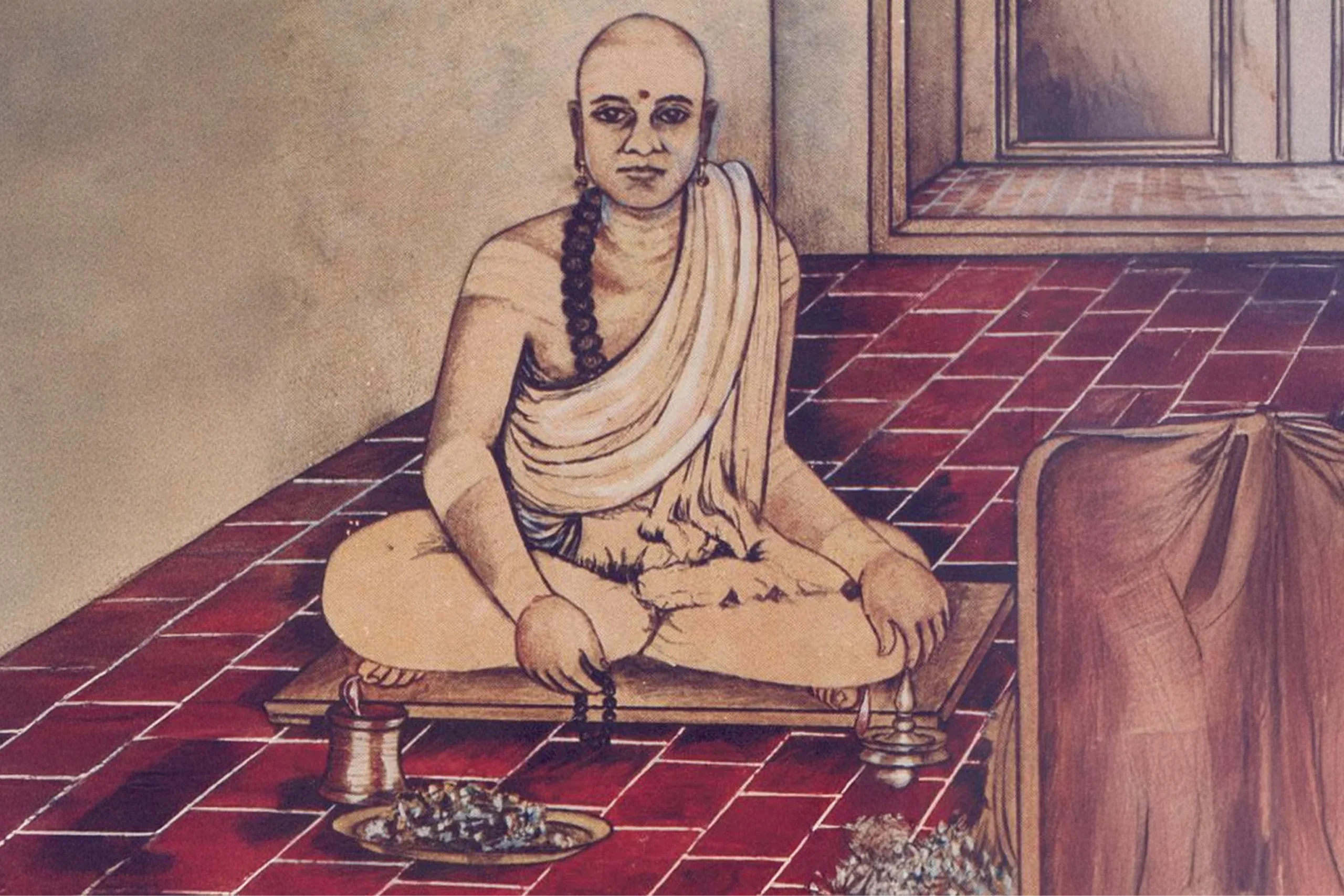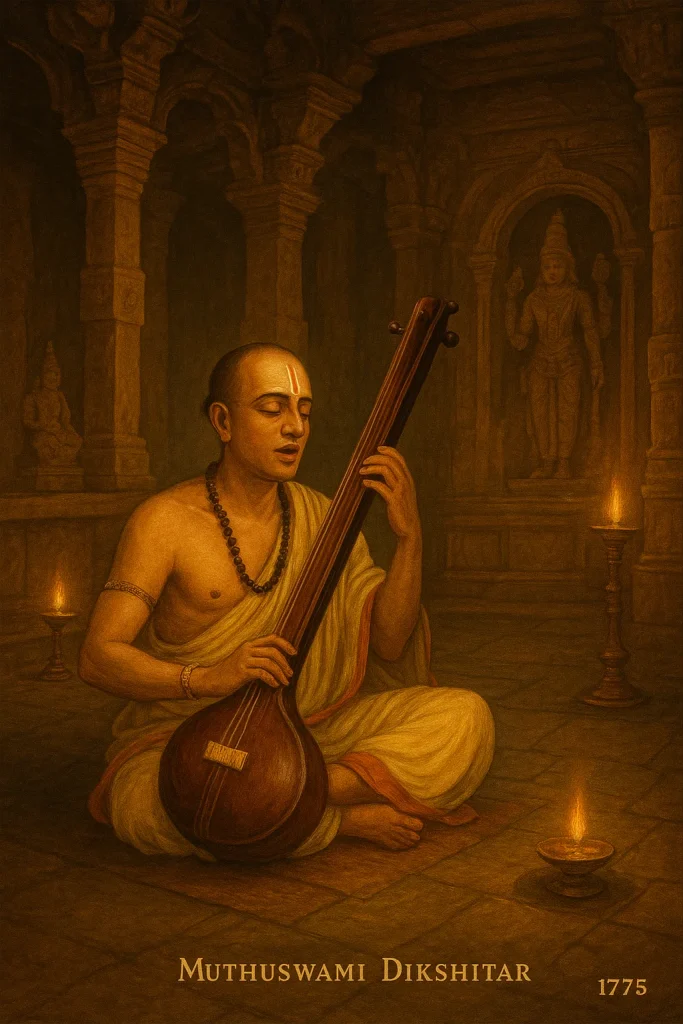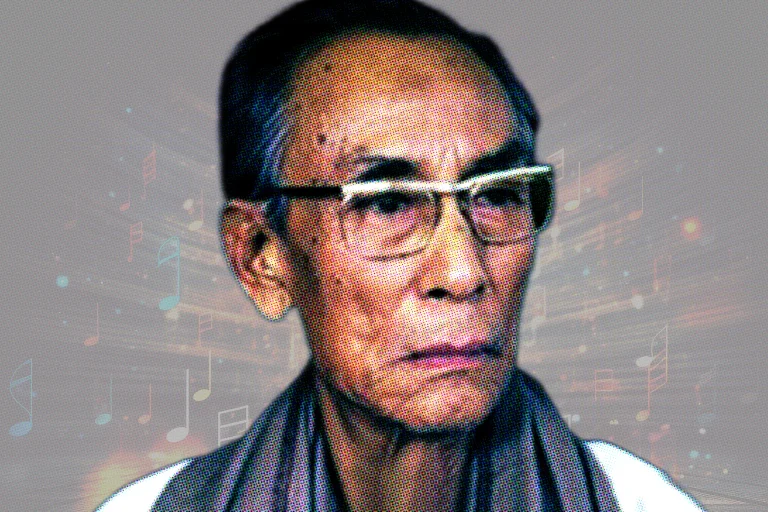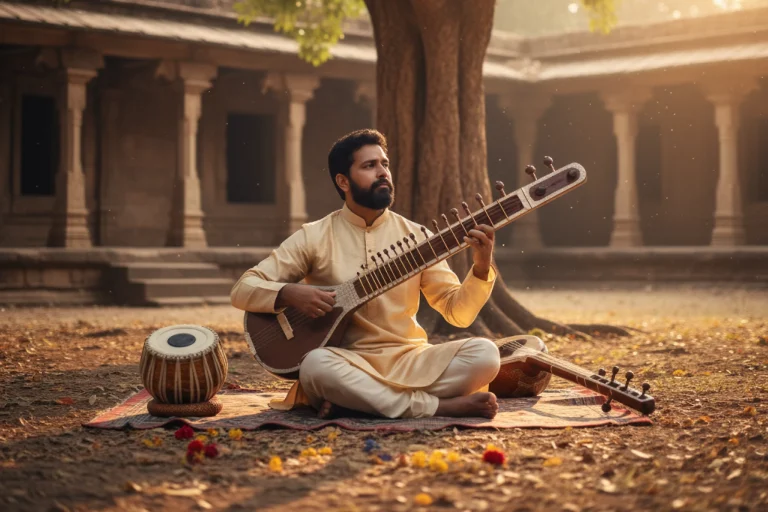All Topics
- Alchemizing Music Concepts for Students
- Artist Spotlight
- artium gift card
- Artium Maestros
- Artium News
- buying guide
- Carnatic Music
- Devotional Music
- Editorials by Ananth Vaidyanathan
- Film Music
- Guitar
- Hindustani Classical Music
- Indian Classical Music
- Indian Folk Music
- Insights
- Instruments
- Karaoke Singing
- Keyboard
- Kids Music
- maestros
- Music Education
- Music for Kids
- Music Industry
- Music Instruments
- Music Legends
- Music Theory
- Music Therapy
- Piano
- piano guide
- Tamil Film Music
- Telugu Film Music
- Time Theory
- Tools
- Uncategorized
- Vocal Singing
- Vocals
- western classical music
- western music
- Western vocal music
Carnatic Music, Indian Classical Music, Music Legends
Remembering the Great Muthuswami Dikshithar On His 250th Birth Anniversary
Remembering the Great Muthuswami Dikshithar On His 250th Birth Anniversary

Table of Contents
Muthuswami Dikshitar, popularly known as Dikshithar, is one among the trinity of Carnatic music (the other two being Tyagaraja and Syama Sastri). He called himself a ‘vainika gayaka’, the one who sings while playing the veena. This year marks the 250th birth anniversary of a gifted musical genius and mystic. Numerous interesting incidents, no shorter than what can be called miracles, are associated with life; let’s contemplate some of them.
Any student or admirer of Carnatic classical music would have undoubtedly come across his popular compositions, such as “Vathapi Ganapathim”, “Sree Saraswathi”, and “Kamalambam Bhajare”, among others. He introduced the Hamsadhwani raga, played a major role in popularising the violin as an apt accompaniment for Carnatic concerts, and composed keerthanas in all the 72 melakarta ragas.
He is also known as Mudduswamy Dikshitar, the only composer to have composed krithis in all 7 basic talas of the Carnatic music system. Dikshithar’s exposure to Western classical bands at a young age paved the way to the beautiful nottuswaras like ‘Sakthi Sahitha Ganapatim’ and ‘Vara Shiva Balam’.
The Birth of a Legend
Dikshithar’s father, Ramaswamy Dikshithar (who was indeed his first Guru), is said to have prayed to Goddess Balambika for begetting a son, worshipping her for 40 days continuously. On the 40th day, the Goddess came in his dream and blessed him with a ‘mukthaahara’ (a garland of pearls).

Soon, his wife conceived, and when a son was born, he was named Muthukumara Swami (“muthu” in Tamil means pearl). It also has a reference to the deity of Subrahmanya, the same deity worshipped in the temple where his father prayed for a son.
Dikshitar was associated with an ascetic named Chidambaranatha yogi, who guided him spiritually and later took him to Benaras. Yogi initiated him into the Sri Vidya cult and was intuitively aware of the tremendous potential his disciple was blessed with and the eternal fame that would be his lot. It was from Benaras, also known as Varanasi, that Dikshithar was exposed to the depths of Carnatic and Hindustani music, as well as philosophy, yoga, and astrology.
He was especially drawn to the Drupad style of music, the influence of which is evident in most of his compositions set to slow to medium tempos (Vilamba to Madhyama kala).

He was also inspired to adopt ragas like Hameerkalyani, Dwijavanthi, and Yamunakalyani in his krithis. After Yogi’s passing away, he miraculously pulled out a veena from the Ganges during his bath. It was a unique instrument with the name “Rama” inscribed on it.
Miracles Associated with Dikshitar’s Life and Compositions
Returning to the South, legend has it that while Dikshithar was in Tiruttani, a town in Tamil Nadu, Lord Subrahmanya came in the guise of an old man, placed a sugar candy in his mouth, and commanded him to sing. The man then vanished into the temple shrine. Recognising it as none other than the lord himself who came to bless him, Dikshithar burst into his first composition “Sree nathaadhi guruguho jayathi” with brimming devotion to the Lord.
He adopted the mudra ‘guruguha’ (another name for Subrahmanya) in all his compositions, following it. This is also said to uphold the concept of Guru, here, Chidambaranatha Yogi. Incidentally, this composition is in Mayamalavagowla, the raga in which musical lessons are traditionally begun.
Aa: S R1 G3 M1 P D1 N3 S
Av: S N3 D1 P M1 G3 R1 S
Another unique feature of this composition is that it starts with the arohanam-avarohanam of the raga. Choosing Sanskrit as his medium, he composed 8 Guruguha-vibhakti krithis. Most of his compositions were born while he traveled to different temples, including Chidambaram, Seerkazhi, Kancheepuram, Tiruvarur, and Mayavaram.
Other Prominent Krithis
The Kamalamba Navavarana krithis can be referred to as the magnum opus of Dikshithar, dedicated to Goddess Kamalambika of Tiruvarur. The Navagraha krithis, a set of nine compositions dedicated to each of the nine planets in the solar system, reflect Dikshithar’s depth of knowledge in the science of astrology. It is interesting to note that they were not just rich in musical brilliance, but singing them with devotion is said to alleviate the adverse effects caused by the planets in a person’s life.
During his stay in a town named Ettayapuram, Dikshithar composed the kriti “Anandamritakarshini” in the raaga Amritavarshini, praying to the goddess for rain. It is said that when he finished writing and while sharing the song with a disciple, a sudden heavy downpour began the moment he sang “Salilam varshaya, varshaya”, bringing an end to the long-time drought that had occurred in the region.
In Keezhvelur, Dikshithar wanted to present his new composition at Lord Siva’s shrine but was denied entry into the temple because the doors were being closed after the day’s rituals. He sat outside and sang his new composition “Akshayalinga vibho” set to raaga Sankarabharanam. At the song’s climax, the temple doors miraculously opened, and Dikshithar was overjoyed to have received the choicest blessings of the Lord.
Diwali and Dikshithar
Diwali is one of the most anticipated festivals in India, celebrated with lights, sweets, and crackers. It marks the return of Lord Rama to Ayodhya and the victory of Krishna over the demon Narakasura. But a lesser-known fact is that this day happens to be the death anniversary of Dikshithar.
The way Dikshithar embraced death requires a special mention. On that day, Dikshithar asked his disciples to sing one of his compositions, ‘Meenakshi memudam’ in Gamakakriya raga. He sat calm, listening and meditating, and while the line ‘Meenalochani pashamochani’ from the charanam was being sung, he breathed his last.
This holds great significance as it refers to Goddess Minakshi as the one who releases her devotees from the bondage of the world. Musicians and music lovers from all over the world come to pay tribute to his ‘samadhi’ (tomb) in Ettayapuram every year, singing and reminiscing about his great compositions.
Paying Gratitude To The Saintly Genius
There might be more miracles associated with Dikshithar; the above are but only a few. Learning and singing his compositions with reverence and trying to assimilate the ‘bhava’ or emotion with which Dikshithar approached each one of them is what we, as students of music, can do to pay our respects to him. Leaving a legacy that transcends time, Dikshithar and his compositions will continue to shine as brightly as ever.

At Artium, an academy dedicated entirely to music education, our goal is to instill in each student a sense of reverence and sincerity when learning music. Only when they realise how blessed they are to learn and sing the compositions of legends do they get genuinely interested in it.
One might compare it with the Guru-disciple system prevalent for Carnatic music classes even today. However, in the modern world where everyone is busy, scheduling classes at their convenience and attending them from the comfort of their homes really matters. Online music classes can prove to be efficient when the student’s potential is channeled in the right direction.
The online Carnatic music course at Artium, particularly in the area of Indian classical music, combines theory and (riyaz) practice; the structured curriculum aims at the holistic development of the learner.
Every teacher assures that this divine art is passed on to their students as effectively as the offline system of teaching music. The tradition is never compromised, while you enjoy the advantages of learning from a global standard online music learning platform from the comfort of your own home.
FAQs
Muthuswami Dikshithar, one among the trinity of Carnatic music, was a legendary musical composer, Veena player, and singer. A saintly figure, he was also well-versed in astrology, scriptures, and poetry. Dikshitar is credited with around 500 compositions, renowned for their elaborate, poetic descriptions of Hindu deities and detailed architectural depictions of temples. His music is notable for capturing the essence of ragas in the vainika (veena) style, which highlights the use of gamakas. His works are usually composed in a slower tempo (chowka kala). Dikshitar used the signature name Guruguha (as a mudra) in all his compositions. They continue to be widely performed in Carnatic music concerts.
Ramaswami Dikshithar, his father, who was himself a proficient musician and composer, taught Dikshithar music. As the eldest son of the composer, Ramaswami Dikshitar, he received instruction in several subjects, including the Vedas, poetry, music, and astronomy. Muthuswami had two brothers, Chinnaswami and Balaswami and a sister, Balāmba. An ascetic named Chidambaranatha Yogi then took Muthuswami under his wing, and they went to the city of Benares (now Varanasi in Uttar Pradesh). There he was instructed in music, esoterics, philosophy, and yoga.
Muthuswami Dikshithar’s compositions are intricate with devotion, distinctive melodic structure and unique ‘raga mudras’ that symbolise the essence of the ragas. He was also a ‘vainika gayaka’, the one who played the veena while singing. Unlike Tyagaraja, who wrote in Telugu, Dikshitar composed mostly in Sanskrit. He introduced and developed many ragas, such as Raga Sankarabharanam, Kalyani, and Kambhoji. He was one of the first to experiment with Western musical influences, evident in his Nottuswara compositions. His songs were deeply rooted in bhakti (devotion) and were dedicated to various deities.
The Kamalamba Navavarana and Navagraha krithis are treasures which embody not only technical brilliance but also Dikshithar’s knowledge and experience in Tantric rituals, Indian philosophy and astrology. The lyrics and the descriptive details are loaded with the mystical symbolism of the Vedantic (advaita) tradition and the chakras of the human system are closely linked to the evolutionary aspects described in the compositions that reflect the scholarly reach, musical depth and mystical significance of the composer. Navavarna refers to the 9 layers of the Sri Chakra yantra, one of the primary modes of Devi worship. Each avarna has a deity associated with it, which is mentioned in each of the songs. The Navagraha Kritis are a set of nine songs composed by Muttuswāmi Dikshitar, a great composer of Carnatic music. Each song is a prayer to one of the nine planets.
Artium Academy follows a well-organized curriculum for all the music courses, especially Carnatic music, guided by one of the greatest singers of our time, Smt. Aruna Sairam. From practicing the basics to developing manodharma and performance-oriented techniques, students are encouraged to devote themselves to pursuing this divine art.
They are also introduced to the interesting facts and anecdotes related to the lives of composers and their compositions, along with a peek into the meaning of the songs they are learning.
Muthuswamy Deekshitar’s kritis comprise a vast collection of Carnatic compositions, distinguished by their Sanskrit lyrics, devotional themes, and distinctive raga and tala structures. His compositions often focus on Hindu deities and include popular works such as the “Mahaganapati” series, the “Navagraha Kritis” (nine planet kritis), and the “Shree” series, dedicated to the goddess Kamalamba. Some well-known examples include “Vatapi Ganapatim” in Hamsadhwani, “Rakta Ganapathim” in Mohana, and “Lambodaraya” in Varali. ‘Anandamrithaakarshini’ in Amritavarshini raga, ‘Akshayalinga vibho’ in Sankarabharanam, ‘Jambupathe’ in Yamunakalyani are some of the many popular krithis of Muthuswami Dikshithar.
A kriti is a genre of musical composition in Carnatic music, serving as the backbone of most concerts. It is a longer format song that typically has three main sections: the pallavi (refrain), anupallavi (second verse), and charanam (final, longest verse). Kritis are set to a specific raga and tala and are an evolution of earlier devotional songs.
Structure of a kriti.
Pallavi: The opening section, functioning as a refrain similar to a chorus.
Anupallavi: The second verse, which follows the pallavi and has its own melodic structure.
Charanam: The final and often longest section of the song. There can be multiple charanams, which often borrow patterns from the anupallavi. Historical context and significance. Kritis evolved from simpler devotional songs, known as keerthanai, which emphasized devotion and had a more straightforward melodic structure. The term can also be used interchangeably with kirtana, although some scholars reserve “kriti” for the more sophisticated, art music form.
The “Trinity of Carnatic Music”—Tyagaraja, Muthuswami Dikshitar, and Syama Sastri, were prolific composers who are credited with shaping the kriti as a major form, introducing significant changes to the tradition. Kritis are fundamental to the Carnatic concert repertoire, providing a longer, more structured framework for musical improvisation and expression.







